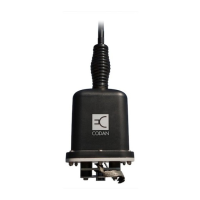Installing the antenna
16 Automatic Whip Antenna 3040 Installation Handbook
Earthing
Most mobile antennas are considerably shorter than a quarter
wavelength at HF, and can exhibit an extremely low radiation
resistance. Consequently, their efficiency is reduced compared
with the quarter-wave radiator that they represent. This can be
improved by good installation practices, and most importantly,
by the provision of a low-impedance earth return for the
antenna.
Due to the relatively poor earth plane surrounding a mobile
HF antenna, best use should be made of what is available. A
reduction in any losses can increase antenna current and
radiation. This can often be achieved by providing a good
earth connection from the base of the antenna to nearby
bodywork. An earth wire is provided for this. Connections to
the vehicle chassis are not as effective because many 4WD
vehicles have insulating mountings from body to chassis.
A strong metal plate that is large enough to support the
antenna will provide efficient earthing. The plate should be
welded to the chassis or some other part of the vehicle’s frame.
The mounting bracket and plate must be free of rust and paint
to allow metal-to-metal contact between the base of the
antenna and the mounting bracket. This electrical bond is the
basis for effective RF earthing. RF currents flow on the
conductor surface, therefore good RF earthing requires
conductors with large surface areas.
The RF earth differs from the DC earth required by the battery
and the vehicle’s electrics. For more information on power
supply factors and earthing the transceiver, see the
documentation provided with the transceiver.
NOTE
Conductive grease should be used on the
touching surfaces to help prevent corrosion.

